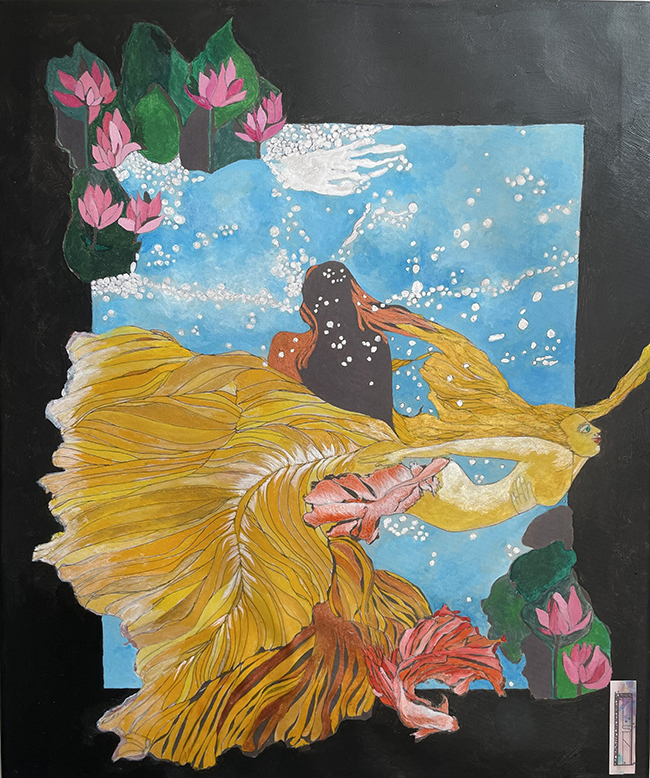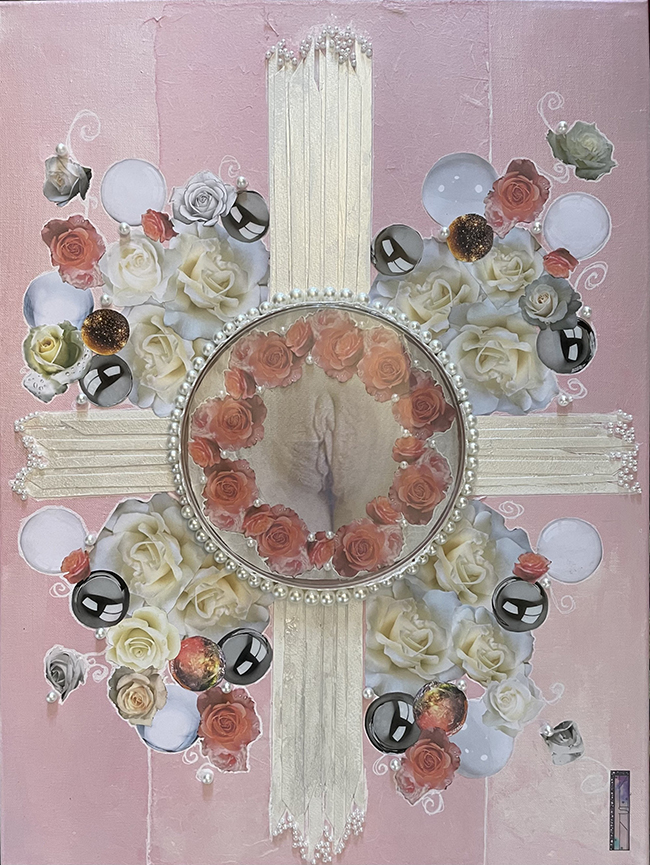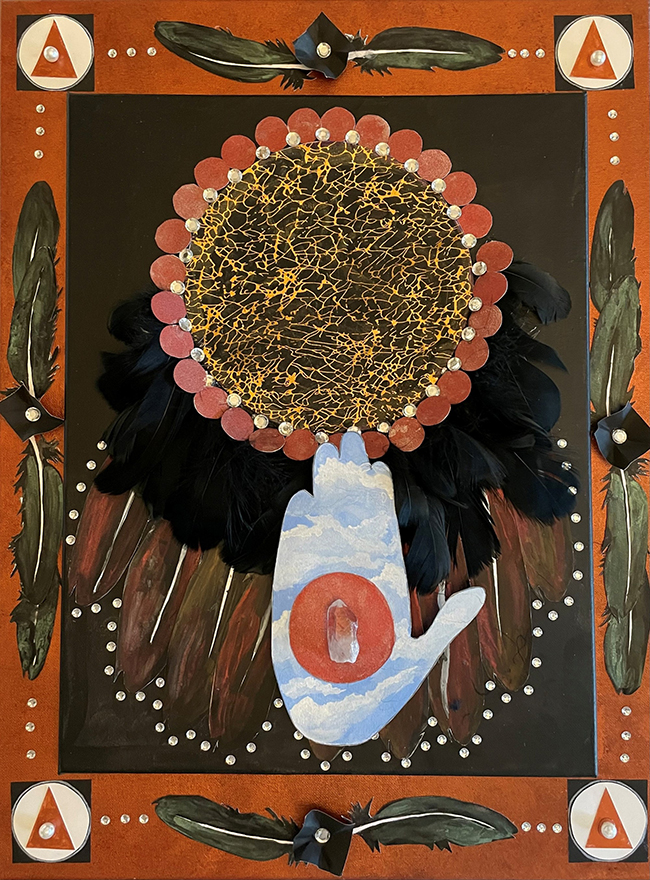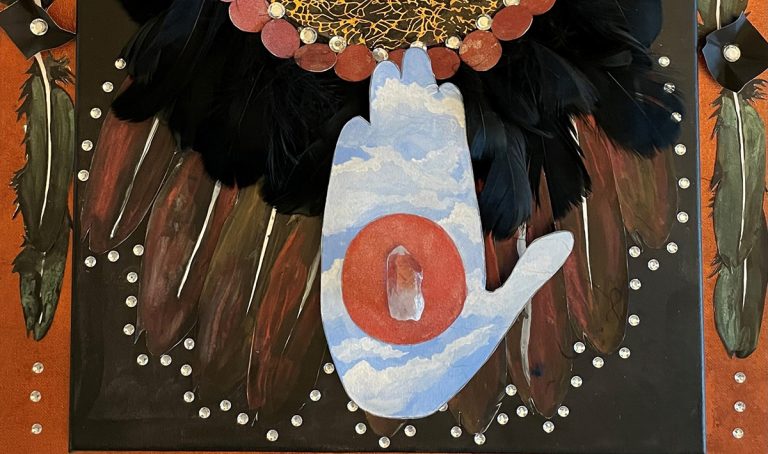Deborah K. Tash, born in 1949 in the Bay Area, merges poetry and painting in a way that’s both personal and mythic. Her work draws from her mixed heritage—Mexican on her mother’s side, Celtic on her father’s—infusing her art with memory, ancestry, and spiritual presence. Identity for Tash isn’t static. It’s woven from place, bloodline, and imagination. The term Mestiza runs deep in how she sees and expresses the world—not as a label, but as a fluid way of belonging to multiple realms at once.
She’s drawn to color and texture, yes, but also to story—especially the ones that live beneath the surface. Her images often carry the feel of ritual objects or dream fragments, built with care and purpose. Whether on canvas or paper, her art often feels like a form of prayer, a way to hold contradictions and possibilities in the same space.
Here’s a closer look at three of her works across different series.
Totem Series / Water Spirit Voices

This acrylic painting hums with movement. Set against a blue background scattered with bubbles, it’s framed in black—containing the image like a captured vision. Bright pink waterlilies bloom in opposite corners, anchoring the composition. But at the center of the piece are the spirits.
Two female water spirits swim through the blue: one golden and ornate, moving forward; the other copper-colored, back turned, her long black hair trailing behind. They’re half-woman, half-goldfish, merging myth with biology. Alongside them, two orange-pink goldfish drift, quiet companions in this dreamlike world.
The piece suggests harmony between seen and unseen beings. There’s no drama here, no storm—just a steady presence. The spirits aren’t pretending to be anything. They simply are. The painting feels like an invitation to notice what we usually overlook: beauty, spirit, and feminine energy hiding in plain sight.
Soft Power Series / Dreaming of Roses

This mixed media collage is bold and intimate. At its core is a stylized depiction of female anatomy placed inside a circular frame. Around it are roses, pearls, glass-like spheres, and soft, swirling details. These objects float and cluster on a pale pink backdrop, forming layers that feel both decorative and sacred.
There’s a strong sense of ceremony in the piece. The central image rests on a glowing cross shape inspired by Native American motifs. Pearls and roses repeat in all directions, like offerings or protective symbols. It’s lush, but not sentimental. Every element seems placed with care.
This work speaks to strength—but not the kind that shouts. It’s part of Tash’s Soft Power series, which explores a form of feminine force rooted in intuition, emotion, and embodiment. The imagery may be provocative, but the tone isn’t aggressive. It holds a quiet firmness. A refusal to hide.
Discourses With The Moon Series / Raven Feather New Moon

In this piece, watercolor meets collage to form something that feels half-spoken, half-remembered. At its heart is an abstract new moon—dark and central. A hand appears beneath it, painted with cloud patterns. The hand holds a copper disk with a crystal embedded in the middle. The gesture feels ritualistic, like a sign or offering.
The border is thick with texture: feathers, rhinestones, metallic disks, and geometric symbols. Eight painted feathers—black and copper—surround the moon. At the corners, pyramids in circles and squares repeat like coded messages. The color palette leans into earth tones, metal, and shadow.
This work feels like it’s listening. There’s no obvious narrative—only presence. The moon doesn’t explain. It reflects. The feathers might be raven feathers or a memory of them. Either way, they mark this space as sacred, transitional, and deeply personal.
Deborah K. Tash’s work unfolds in layers. Her art doesn’t aim for a tidy message. It offers a place to pause. To reflect. To sit with the past and the unknown. Her pieces carry a pulse—sometimes soft, sometimes direct—but always grounded in meaning.
You can view her work on Fine Art America:
👉 fineartamerica.com/profiles/deborah-tash
Tash continues to create from the margins where poetry meets painting, where heritage meets spirit. Her art reminds us that we don’t have to choose one world or one way of seeing. We can belong to many. And we can let that multiplicity bloom.

